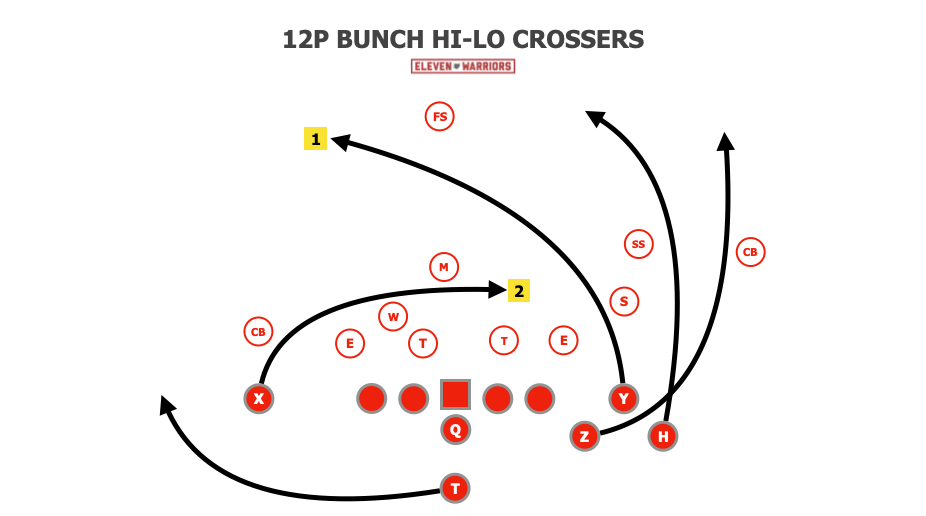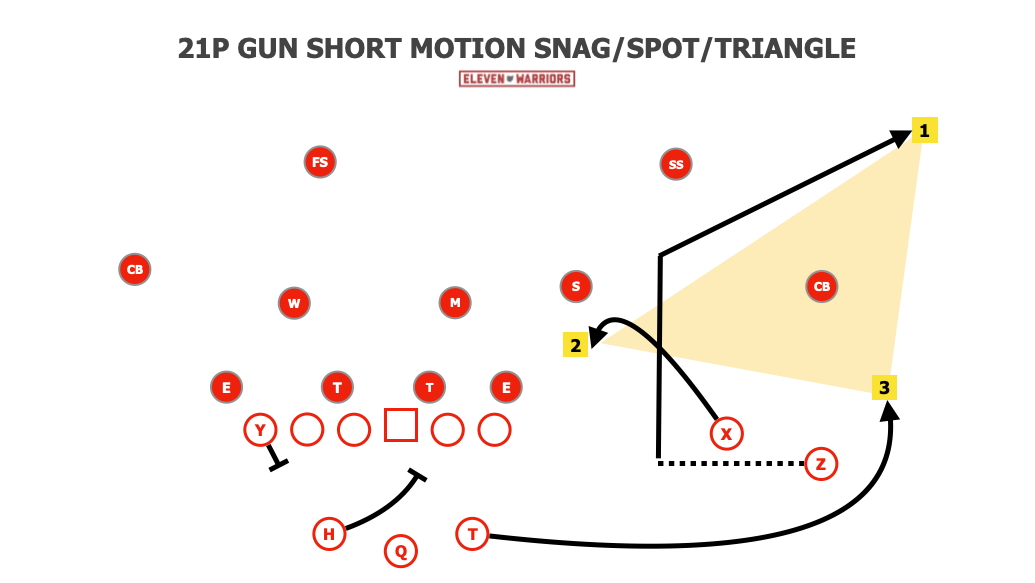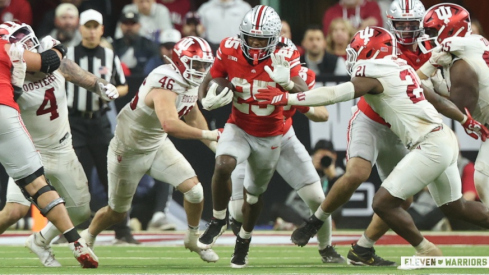Philip Rivers has thrown 7,591 career NFL passes in his 16-year (and counting) NFL career. His career passer rating of 95.1 is tenth-best all-time among NFL quarterbacks, and he currently ranks sixth all-time in both passing yards and touchdowns.
Yet despite his accomplished professional career, Buckeye fans of a certain age remember him for his lone appearance in Ohio Stadium, when he nearly engineered an upset of the reigning national champions on their home turf.
In the third week of the 2003 season, Ohio State welcomed Rivers and the North Carolina State Wolfpack to the Horseshoe for the second highly-anticipated out-of-conference matchup in three weeks. But after easily dispatching #17 Washington under the lights on the opening night of the season, the Buckeyes stumbled the following week against San Diego State, requiring a 100-yard pick-six from Will Allen to sneak away with a 16-13 win over the 32-point underdogs.
N.C. State also limped into this contest, giving up 38 points to lowly Wake Forest and suffering an unexpected 14-point upset at the hands of their in-state foes. Yet the two teams remained ranked heading into their matchup; one which few would forget.
Going into the game, however, much of the media focus centered on the absence of star running back Maurice Clarett, who had been embroiled in an academic scandal in the summer and was no longer with the team.
"Maurice is a great running back," senior wideout Drew Carter said of his teammate. "He would help our team if he was here, but we can't look at the past. We just have to strive forward and work hard every day, so we can do it without him."
As the early moments of the contest would show, however, that was easier said than done. The Buckeyes' conservative, ground-based attack struggled to find any room against the Wolfpack, with Clarett's replacements at tailback, Maurice Hall and Lydell Ross, combining for just 7 yards on 17 carries.
Though Rivers was clearly the face of the Wolfpack program at the time, they were led by Chuck Amato, who had been a key figure behind Bobby Bowden's dominant Florida State defenses of the 90s. While in Tallahassee, Amato had prioritized speed over everything else, a philosophy which he brought to Raleigh and was epitomized by the recruitment of Mario Williams, who spent his third collegiate game chasing down Buckeye running backs.
Without the real threat of a run game, the Buckeye offense instead centered on quick timing patterns, even if it meant running play-action from the I-formation on 3rd & 7. Despite the passive alignment, QB Craig Krenzel made enough plays from the pocket to keep the OSU offense moving in the opening moments.
After trading punts, the Buckeyes sprung the first big play of the game by going to the best playmaker they had left, targeting Michael Jenkins on a short crossing route. With Amato's defense in man-coverage and the middle vacated by three vertical routes from the opposite side, one hesitation from the corner (and a little help from the umpire) was all that was needed to open up Jenkins for a 44-yard catch-and-run

On the ensuing kickoff, the Buckeyes would catch the first of many breaks that day as the Wolfpack muffed the kick and Allen fell on the ball at the N.C. State 3-yard line. Two plays later, Ross would punch in a short touchdown run and the home team appeared to be off to the races.
The Wolfpack struggled to get anything going in the first half, as they failed to establish any ground game without their own star back, T.A. McLendon, who was nursing a strained patella and was used only as a decoy before halftime. As a result, the Buckeye defense could comfortably drop seven into coverage and still get pressure thanks to a talented front four of Tim Anderson, Simon Fraser, Darrion Scott, and Will Smith.
Using the playbook he brought from his days working under Nick Saban in East Lansing, OSU defensive coordinator Mark Dantonio played a mix of man and zone schemes that seemed to confuse Rivers, forcing him to hold the ball long enough for the pressure to arrive.
Often, this came in the form of Smith playing a standup Leo position in which he appeared to be spying Rivers instead of sprinting out of his stance. The idea was not for Smith to keep Rivers from scrambling, but rather, it allowed the All-American to wait for gaps to appear in the pocket allowing him to dart in and bring down the QB.
After punting on four straight possessions, Rivers finally flashed some of the traits that would serve him so well at the next level. With OSU corners Dustin Fox and Chris Gamble playing off coverage to not get beat deep, Rivers began throwing quick comebacks and outs underneath the defenders before pressure could arrive.
The senior QB went a perfect 5-5 on the drive as he connected with star wideout Jerricho Cotchery on a fake WR screen which forced the two defenders in man-coverage to collide. All of a sudden, the Buckeye lead was cut in half as the two teams went into the intermission
As the two teams emerged from the break, however, that scoring drive appeared to have been an anomaly, as the teams continued to trade punts throughout the third quarter. With the period winding down, Rivers made his first real mistake of the day, forcing a ball to a crossing route before pressure arrived, only to watch it land directly in the hands of OSU linebacker A.J. Hawk who rumbled all the way down to the Wolfpack 7-yard line.
The OSU offense failed to capitalize on the great field position, though, coming away with only a Mike Nugent field goal after a penalty, two stifled runs and an incomplete pass. Just a few plays later, though, the Buckeyes would get yet another chance.
Rivers forced another errant pass over the middle as he evaded pressure, this time with free safety Brandon Mitchell coming up with the ball. However, TV replays clearly showed he had trapped it after it bounced on the ground, but officials wouldn't have access to such views for another three years and the interception stood.
This time, the OSU offense wouldn't let the opportunity slip away.
On a critical 3rd & 3 a few snaps later, Krenzel recognized the corner pressed up against Jenkins to one side. Just as he had a year earlier in West Lafayette, Krenzel looked the opposite way as he took a quick three-step drop, holing the free safety in the middle of the field.
As his third step hit the ground, Krenzel flipped his hips back toward Jenkins and lofted a perfect pass over the head of the beaten cornerback, resulting in a 29-yard gain.
Without Clarett in the backfield, the Buckeyes leaned on the 6'4" 228 lb Krenzel as their short-yardage back, using a lead fullback and pulling guard to pave the way on this QB Power play. The lead was back up to 17 with just 11 minutes to play and the home crowd could finally sit comfortably.
But after Santonio Holmes fumbled on a punt return a few minutes later, the Wolfpack was gifted great field position in the red zone. Instead of kicking a field goal on 4th & 2, though, Rivers found Cotchery on a wide-open corner route (more on this play later), cutting the lead back to just 10.
As the Buckeyes took possession, they went backward, negating Hall's only big run of the day with a holding call followed by a 5-yard loss, a delay of game penalty, and an incomplete pass. All of a sudden, Krenzel faced 3rd & 21 from the shadow of his own end zone.
Everyone in the stadium expected the Buckeyes to go full Tresselball but were shocked to see Krenzel break the huddle in an empty formation. The Wolfpack showed pressure only to drop eight players into coverage, yet the OSU offensive line struggled to identify the three remaining rushers and forcing Krenzel to chuck up an arm punt instead of risking a potential safety.
The Buckeye defense would hold firm this time around, forcing Amato to send out the field goal team four plays later, but the lead was now just seven points with just under six minutes to play. Ohio State would go three-and-out before eventual Ray Guy award winner B.J. Sander boomed a 57-yard punt which was downed at the Wolfpack's own 14.
With 3:18 to play and 86 yards to cover, Rivers and play-caller Noel Mazzone leaned on one of the few concepts which had been successful that afternoon. McLendon had gutted through the second half despite his knee injury, making the Wolpack's best personnel package a two-back set with he and Tramain Hall flanking Rivers in the shotgun.
Just as they had on the touchdown pass earlier in the quarter, Mazzone began employing motion from this set to force the OSU defense to show whether it was in zone or man coverage. When Cotchery came across the formation or slipped inside the other receiver, Rivers would watch to see if the defender would follow him (signaling man-coverage) or if the defenders would simply shift over (signaling zone).
After the snap, Mazzone gave Rivers a simple half-field read in the shape of a triangle. The concept, known Snag, Spot, or just Triangle is a common one still often used today and was a favorite of Ryan Day and Justin Fields this past season in Columbus.
As Chris B. Brown of Smartfooball.com wrote of it years ago:
The basic concept involves one receiver in the deep third on a corner route (good by itself against man-to-man), one receiver in the flat, often a running back or inside receiver (which can also be good against man from a bunch-set), and a third receiver on the “snag” route, sometimes also known as a “slant-settle” or a “mini-curl.”
As a general matter, against a Cover 2 defense the quarterback will have a high/low read of the corner; if he sinks back he can throw it to the inside receiver in the flat; if the cornerback drops he will throw it to the corner route behind the cornerback.
Against a Cover 3 defense, the cornerback should take away the corner route by dropping into the deep third, but the snag/mini-curl and the flat should put a horizontal stretch on the flat defender and one of the two should be open.
Putting these two reads together creates the triangle, thus giving options against a variety of coverages.

The Buckeyes chose to employ a three-deep zone on the first few plays of the drive, meaning the curl-flat defender was stressed by the snag route and McLendon in the flat, leading to Rivers looking his way on back-to-back plays and picking up 39 quick yards.
With time running down, the Wolfpack would get inside the Buckeye 10-yard line a few plays later, leading Mazzone to dial up the Snag concept once again. This time, though, the Buckeyes' man-coverage blanketed it perfectly and forced Rivers to improvise.
As he stepped up in the pocket to buy time, Rivers noticed tight end T.J. Williams standing all alone. The defender responsible for covering him, Fox, had dropped off to help the other coverage players after seeing Williams stay in to block, and couldn't recover in time to keep the big man from lumbering into the end zone and tying the game.
The crowd inside the Horseshoe was stunned as Krenzel took a knee to send the game to overtime, having watched the defending national champions surrender a 17-point lead at home. But the moment was a historic one, as Ohio Stadium was set to host its first contest to reach overtime in its 81 years since opening.
As he had in Tempe, Arizona nine months prior, Krenzel stepped up once again to come through in the biggest moments. Facing 3rd & 6 on the opening possession of overtime, OSU called for the same crossing route to Jenkins that he'd scored on in the first half, just flipping it the other way.
This time the Wolfpack properly picked up Jenkins over the middle, but Krenzel bought enough time in the pocket for Ben Hartsock to break off his route and find open grass in the back of the end zone. The catch was Hartsock's sixth of seven that day, a career-high for the tight end who'd go on to play 10 years in the NFL.
As the Wolfpack took possession, Mazzone went right back to the same Snag concept that had worked so well in the fourth quarter. Rivers correctly diagnosed McLendon's matchup with middle linebacker Fred Pagac, which immediately set up N.C. State inside the 10.
Rivers would take an 8-yard loss on the next play, though, forcing the Wolfpack to spread out and pass for the following snap. With more field to cover, the Buckeyes called for three-deep zone coverage, against which the Wolfpack ran four vertical routes, stressing the seams.
The veteran QB immediately recognized the opening and perfectly hit Hall in the small window between the cornerback and safety, extending the game further.
As the Wolfpack took possession to start the second OT, they received another break as a pass interference penalty on third down renewed the drive. The Ohio Stadium crowd erupted with anger as the field judge's call was overruled by the referee, setting up 1st & goal from the 2-yard line.
For the first time that afternoon, the Wolfpack could finally unveil a goalline package which they'd clearly prepared just for this contest.
After lining up in a strange, unbalanced alignment that appeared to be setting up a fumblerooski trick play, the offense motioned out to a wide bunch with four receivers to one side. The bunch set was not there to set up a screen pass, however, but to pave the way for McLendon on a pitch outside, allowing him to outrun Smith on his way into the end zone.
Now trailing for the first time all game, Krenzel and Jenkins put the team on their shoulders, working quick slants off play-action that moved the ball in place of a running game.
After a 2-yard touchdown pass to Ryan Hamby took the game to a third overtime, the OSU gameplan didn't change. Krenzel kept looking Jenkins' way as the junior hauled in his seventh catch, giving him 124 yards receiving and two touchdowns.
"We do a pretty darn good job of putting the ball in the end zone," Krenzel said following the game, "especially when we're in the red zone."
But the Buckeyes would fail to convert the forced two-point conversion as Krenzel's pass was knocked down at the line, giving the home team just a 6-point lead.
Upon taking possession, three completions and a defensive holding call setup the Wolfpack with 1st & goal from the OSU 4, and all 104,890 fans rose from their seats. Once again near the goalline, Mazzone unveiled more trickery as he tried to confuse the defense.
After initially lining up in a heavy set, the Wolfpack motioned all five skill players to the numbers, leaving Rivers alone under center. The Buckeyes weren't caught off guard, though, as they stuffed the QB sneak on first down as well as when they tried the same play again two plays later.
"They were spreading it out and nobody was in there," Rivers said. "We can analyze those calls over and over. We had our chances."
Now with just one last chance to punch the ball in from the 2-yard line, Mazzone dialed up the same play that sprung McLendon in the previous OT but flipped it in the opposite direction. But as McLendon cut up towards the goalline, Allen appeared out of nowhere to stuff the runner before he could extend the ball into the end zone.
"[I knew] he wasn't in," said Allen after the game, a senior who would earn All-America honors that fall. "I just got him low and came up."
Neither offense played particularly well that afternoon, with the Wolfpack outgaining the Buckeyes with 336 total yards to just 317. Neither team could run the ball effectively, combining for just 65 net rushing yards on 62 carries.
But though both quarterbacks made mistakes, they both carried their teams in the most important moments. Rivers finished the day 36 of 52 for 315 yards passing while Krenzel completed 26 of 36 attempts for 273 yards and 4 TDs, both career highs.
In many ways, the three-OT thriller would be the season highlight for both teams that fall. The shadow of Clarett's absence would cloud the entire season, as the Buckeye offense would continually sputter and eventually fall in an ugly 17-10 loss at Wisconsin along with a 35-21 loss in Ann Arbor, Jim Tressel's only loss to his rivals up north.
Similarly, the Wolfpack would drop from the rankings following this loss and would never return as they would go on to lose to Georgia Tech, Florida State, and Maryland, finishing with just an 8-5 record, despite Rivers' 4,491 passing yards and 34 touchdowns, both ACC records at the time. But though he'd be crowned conference player-of-the-year, he wouldn't be invited to New York for the Heisman ceremony due to his team's underwhelming record.
While the 2003 season wasn't the most memorable for fans of either program, those in attendance that warm September afternoon remember one of the most exciting contests in Horseshoe history.
"What a great football game we witnessed today," Tressel said after the game. "Two teams went after it, played their hearts out and it ends on the half-yard line. What a fitting end for the effort given by both teams."


